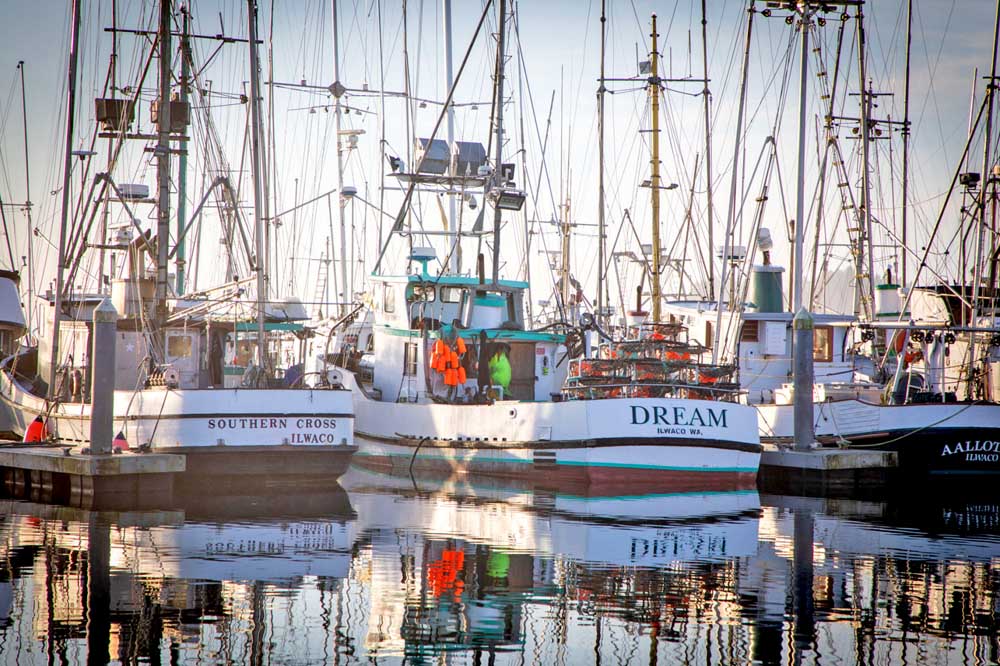One step ahead of the muck: Vital dredging keeps river ports alive
Published 12:45 pm Monday, December 16, 2019

- The annual dredging is necessary to retain navigable port channels and moorage access for the commercial and recreational fleets in Ilwaco and Chinook.
ILWACO — The list reads like a local garage sale: bikes, tires, power tools, and lots of miscellaneous fishing equipment, from old rods to lead weights.
Trending
Instead it’s the list of items discovered during annual dredging in the Port of Ilwaco mooring basin, where a lot more than silt is sucked from the bottom of the 800-slip marina.
New role for port staff
Annual dredge work brings new roles as port staff tackle dredge duties and maintenance crew split boatyard and regular responsibilities.
Dredging is typically a two- or three-man operation, with one person manning the controls and another keeping the suction and cutter head free of debris.
For port maintenance crewmember Tony Kary, a primary responsibility is removing random debris that routinely catches in the dredge cutter head. It’s this necessary hands-on dirty work that permits the dredge operator to continue pulling up silt smoothly and efficiently.
Efficiency is paramount to maximize the impact of the allotted in-water work window coordinated weeks in advance with tide conditions and migrating salmon. Careful calculations are made considering the amount of silt that needs to be removed from the shallowest areas, how long it will take and where it will go. On average the dredge can move 50 to 75 cubic yards of silt per hour. The worst impacted spots are dredged first, but an efficient season requires precise planning.
The main dredge controls feature eight identical manual levers and six primary gauges that the operator must observe and maneuver in unison to operate the machine effectively. Becoming a skilled and efficient dredge operator can take several months.
“There’s a lot of stuff going on,” conceded dredge operator Jon Haataja, 36, describing the job he’s handled for more than 15 years along with his brother, Jeff.
Figuring out all the gauges — including pump speed, vacuum and discharge pressure — are among the unique challenges.
“And not breaking anything,” Jon added jokingly.
The Port of Ilwaco started its maintenance dredging program nearly 20 years ago, which has improved the overall condition of the marina.
“We have been aggressively dredging each year since we purchased our newer dredge in 2013,” said Port Manager Guy Glenn Jr. “Not many ports own and operate their own dredge each year and our staff does a great job both operating the dredge and maintaining it in the off-season.”
Dredging costly, vital
The annual dredging is necessary to retain navigable port channels and moorage access for the commercial and recreational fleets in Ilwaco and Chinook.
“Our priorities are the commercial docks and deeper-draft areas for larger vessels to transit the marina, including access to the fuel dock, boatyard and live-bait facility,” Glenn said. “It is critical for our commercial fishing fleet and upland seafood processors to have reliable access.”
The silt sitting at the bottom of the Port of Ilwaco and Chinook is up to 80% clay. Roughly four vertical feet of clay-heavy silt will be removed from the port bottom on average.
“Our plan is to remove around 30,000 cubic yards of dredge material from the Port of Ilwaco marina in this work window,” Glenn said. “Typically, we remove around 15,000 to 25,000 cubic yards.”
That’s enough silt to fill more than nine Olympic-sized swimming pools, which will be sucked from the bottom of the Port of Ilwaco between now and Feb. 28, 2020.
Up to 29,000 cubic yards of sediment settles in the Port of Ilwaco each year, according to 2019 study by Coast and Harbors Engineering. This sediment, a fine silt/clay mixture, is suspended in the water and flows into the marina due to tides and river currents, and from wave action within Baker Bay. A federal permit allows the port to remove up to 50,000 cubic yards a year.
Dredging is an expensive but necessary endeavor for the port, despite not being as apparent as other projects.
“Our investment in maintenance dredging is significant,” Glenn said.
“Most ports don’t have to dredge each year,” he continued. “The challenge with maintenance dredging is that it is invisible to the general public. If we were to spend $150,000 to $200,000 each year on a physical asset, like a new dock or other land-based infrastructure, it could be seen. When performing maintenance dredging, there is nothing visible for the public to see, yet it is a critical part of our navigation infrastructure. By owning and operating our own dredge in our marina, we provide value to our customers and local taxpayers. Contracting for annual marina maintenance dredging would be significantly more expensive.”
Only the Port of Ilwaco will be dredged this season, but Glenn is hopeful of securing federal funding for the Port of Chinook next year.









